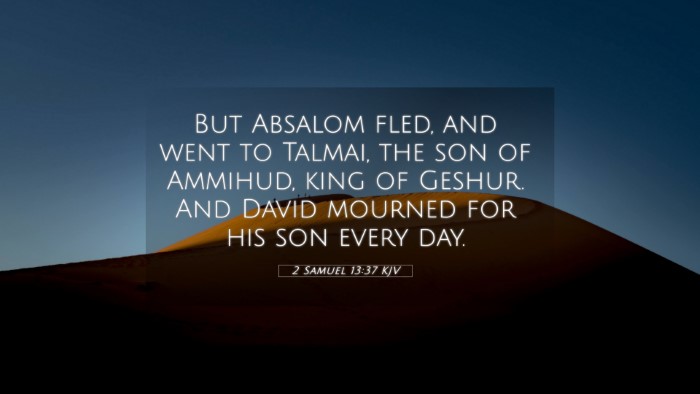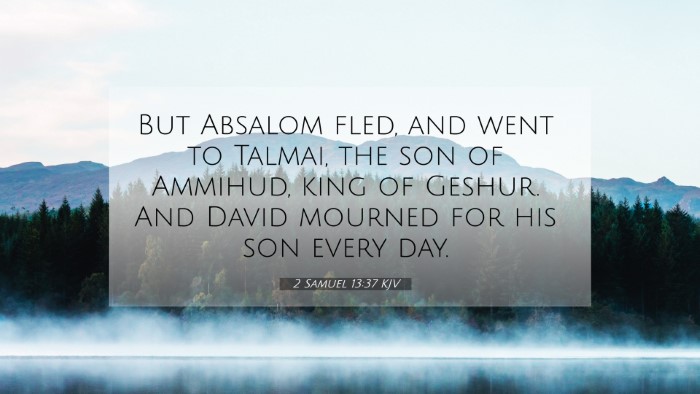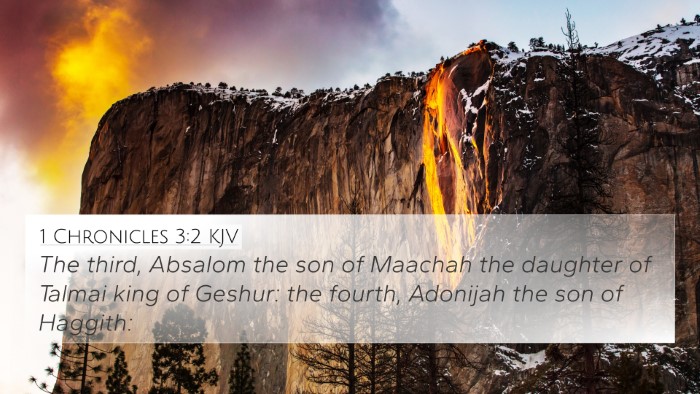Understanding 2 Samuel 13:37
Verse: 2 Samuel 13:37 KJV reads: "But Absalom fled, and went to Talmai, the son of Ammihud, king of Geshur. And David mourned for his son every day."
Contextual Background
This verse comes after the tumultuous events surrounding the actions of Amnon and Absalom. Amnon's assault on Tamar led to Absalom's vengeful act of murder against his half-brother Amnon, which caused Absalom to flee from King David. This verse encapsulates the emotional turmoil experienced by David as he copes with the loss of his son, the treachery in his family, and the rebellion brewing in his kingdom.
Summary of Insights from Commentaries
- Matthew Henry: Reflects on the depth of David's sorrow, emphasizing the heartfelt nature of a father’s love amidst chaos. He points out that this mourning not only represents personal loss but also showcases the broader consequences of sin within David's household.
- Albert Barnes: Highlights the implications of Absalom’s flight and David's grief. Barnes notes that David’s mourning displayed his paternal affection but also his lack of authority in dealing with sin and rebellion within his family, drawing parallels to his own past failures.
- Adam Clarke: Emphasizes the significance of Geshur as a place of refuge for Absalom. Clarke connects this flight to Absalom's later attempts to wrest control from David, illustrating how unresolved grievances can lead to greater conflict.
Thematic Bible Verse Connections
This verse relates to multiple themes within the Scriptures, such as parental grief, familial discord, and the consequences of sin. Below are some notable cross-references:
- 1 Samuel 15:35: “And Samuel came no more to see Saul until the day of his death: nevertheless Samuel mourned for Saul…” — Illustrates similar themes of mourning within familial relationships.
- 2 Samuel 14:1: “Now Joab the son of Zeruiah perceived that the king's heart was toward Absalom.” — Highlights the complex relationships within David’s family.
- Galatians 6:7: “Be not deceived; God is not mocked: for whatsoever a man soweth, that shall he also reap.” — This speaks to the consequences of David’s prior actions affecting his family life.
- 2 Samuel 18:33: “And the king was much moved, and went up to the chamber over the gate, and wept: and as he went, thus he said…O my son Absalom, my son, my son Absalom!” — This connects David's ongoing grief throughout the narrative.
- Psalms 30:5: “For his anger endureth but a moment; in his favor is life: weeping may endure for a night, but joy cometh in the morning.” — Provides a perspective on mourning and hope.
- Proverbs 22:6: “Train up a child in the way he should go: and when he is old, he will not depart from it.” — Relates to the importance of guidance and discipline in parenting.
- Luke 15:24: “For this my son was dead, and is alive again; he was lost, and is found. And they began to be merry.” — Reflects themes of loss and recovery within the family.
- 2 Samuel 16:21: “And Absalom said unto Ahithophel, Give counsel among you what we shall do.” — Marks Absalom's turn towards rebellion, fueled by familial strife.
- Matthew 10:21: “And the brother shall deliver up the brother to death, and the father the son: and the children shall rise up against their parents, and cause them to be put to death.” — Jesus’s words highlight the tragic fracturing of family bonds.
- Genesis 37:35: “And all his sons and all his daughters rose up to comfort him; but he refused to be comforted; and he said, For I will go down into the grave unto my son mourning…” — This illustrates deep parental sorrow similar to David's mourning.
Conclusion
The events surrounding 2 Samuel 13:37 are pivotal in understanding the themes of loss, grief, and the ripple effects of sin within families. This verse serves as a solemn reminder of how individual actions can lead to profound sorrow and disunity, not just within a family but potentially extending into the broader community. Various cross-references, including both Old and New Testament verses, provide further insight into the depth of these themes and the interconnectedness of Biblical narratives.







